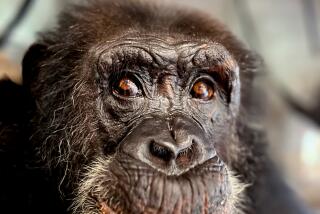When the Show’s Over for Hollywood Chimps
Ollie and Buddy, the chimpanzees shot dead earlier this month after they viciously attacked a couple at a Kern County animal sanctuary, had been retired from show business after having spent their early years working for one of Hollywood’s top animal trainers.
Their background underscores how tough a business Hollywood can be for chimps these days and how hard it is to find a place for them to live once their performing days are over.
For the record:
12:00 a.m. March 23, 2005 For The Record
Los Angeles Times Wednesday March 23, 2005 Home Edition Main News Part A Page 2 National Desk 1 inches; 38 words Type of Material: Correction
Hollywood chimpanzees -- An article in Tuesday’s California section said the Humane Society of the United States oversees the treatment of animals on some film sets. A different organization, the American Humane Assn., monitors animals on movie sets.
The 11-year-old male chimps had been sent to Animal Haven Ranch in Havilah seven years ago after they grew too strong and unpredictable to work with humans. Chimps are used in the entertainment industry only for the first few years of their lives because they become too difficult to handle, animal experts said.
Many end up spending the rest of their lives -- which can be another 50 years -- in sanctuaries similar to the one in Kern County. Others, animal rights activists fear, end up being used for medical research.
“By around [age] 7 or 8, they start changing,” said trainer Steve Earl Martin, owner of Steve Martin’s Working Wildlife in Frazier Park, which provides tigers, monkeys, birds and other creatures for movie and TV productions. “That’s just the way they are. It’s part of their mind-sets.”
Chimps have long been one of the most popular animals in show business, lending comic relief to TV shows, movies and commercials, as well as circuses and other live acts. Producers turn to them because of their human-like qualities. They can smile on cue, perform basic tasks and look sharp in human outfits.
But in recent years, the demand for live chimps and other simians has declined as digital animation allows filmmakers and TV producers to create their likenesses on computers. The chimps and other animals in Eddie Murphy’s remake of “Dr. Dolittle,” for example, were computer-generated.
“With computers and animatronics and such, there’s not as much demand for chimps and live animals anymore,” said Martin, who still provides chimpanzees to Hollywood.
Endla Burrows, director of Jim Henson’s Creature Shop in Los Angeles, said studios tend to prefer computer-generated and animatronic creatures because they provide complete control over the performance.
“One of the biggest things is you’re spending thousands of dollars per minute of time,” Burrows said. “Even if a real animal could be trained to do it, there’s no guarantee you’ll get the performance you’re looking for. With animatronics or computer graphics, you’re getting the exact performance you want, exactly when you want it.”
Creature Shop did the animals for “Dr. Dolittle” as well as “George of the Jungle,” and its staff just finished creating pigeons for a new film version of “The Producers.”
It’s unclear exactly what Ollie and Buddy did during their time in Hollywood. They trained with chimpanzee specialist Bob Dunn at his Sylmar compound, the place where Bubbles, the chimp that Michael Jackson once owned, came from. More recently, Dunn trained Sammy, the orangutan who starred in the film “Dunston Checks In.”
Dunn is a legend in the Hollywood animal world, known for his skilled and patient training of chimps for specific roles. About a year and half after a chimp was born in his compound, he would start basic acting training, teaching the words “no,” “sit” and “stand.” In a couple of years, they were ready to take on film and TV roles.
While some animal rights activists said he exploited the animals, Dunn always insisted he treated them with great care and respect. A spokeswoman for the Humane Society of the United States, which regulates the care of animals on movie sets, said Dunn treated his animals well.
“I think he knows chimpanzees better than anyone I’ve ever met,” said Patti Ragan, founder of the Center for Great Apes in Wauchula, Fla., which took Dunn’s 11 chimps and six orangutans when he shut down his ape operation this year.
Ragan said she visited Dunn at the Sylmar compound a few years ago and was impressed with how well he managed his animals. She said she didn’t know why Dunn decided to quit handling chimps but that he had told her he was tired of the periodic protests by activists.
One of the biggest concerns of activists is what happens to primates after their show-business careers end. Some rights groups have speculated that chimps and other animal performers are sold to medical research or euthanized. Dunn vowed in a 1988 interview with The Times that he would never sell his chimps to research.
Had Ollie and Buddy had been born seven years later, they might have ended up at Ragan’s compound. But they had retired several years earlier and landed at Animal Haven Ranch. It was there March 3 that Ollie and Buddy somehow escaped from their cages and mauled St. James and LaDonna Davis. A ranch worker ended the attack by shooting the two chimps with a rifle.
St. James Davis, who along with his wife was there to celebrate the birthday of another chimp, Moe, suffered severe wounds to his face, hands, feet and buttocks and was in critical condition at Loma Linda University Medical Center.
The state Department of Fish and Game is investigating the incident. Spokesman Steve Martarano said the focus will be on what happened at the ranch that day. Investigators don’t plan to look into Ollie’s and Buddy’s past.
Ragan said she is glad Dunn closed his ape operation and that computers are making chimp performances less common.
“The closing of this primary supply of great apes in the entertainment business is a major step toward ending the use of apes in entertainment,” Ragan said.
“These are sentient, intelligent animals, not just little pseudo-humans and clowns. It’s becoming more and more politically correct not to use chimp acts anymore. Ringling Bros. hasn’t used them since 1993.”
Burrows, with Jim Henson’s Creature Shop, said high technology offers another benefit.
The only time she hears from animal rights groups, she said, is “when we’ve done really good animal work and they see the movie and say, ‘I can’t believe you let that happen to an animal!’ But that’s a compliment on several levels.”
More to Read
The biggest entertainment stories
Get our big stories about Hollywood, film, television, music, arts, culture and more right in your inbox as soon as they publish.
You may occasionally receive promotional content from the Los Angeles Times.










